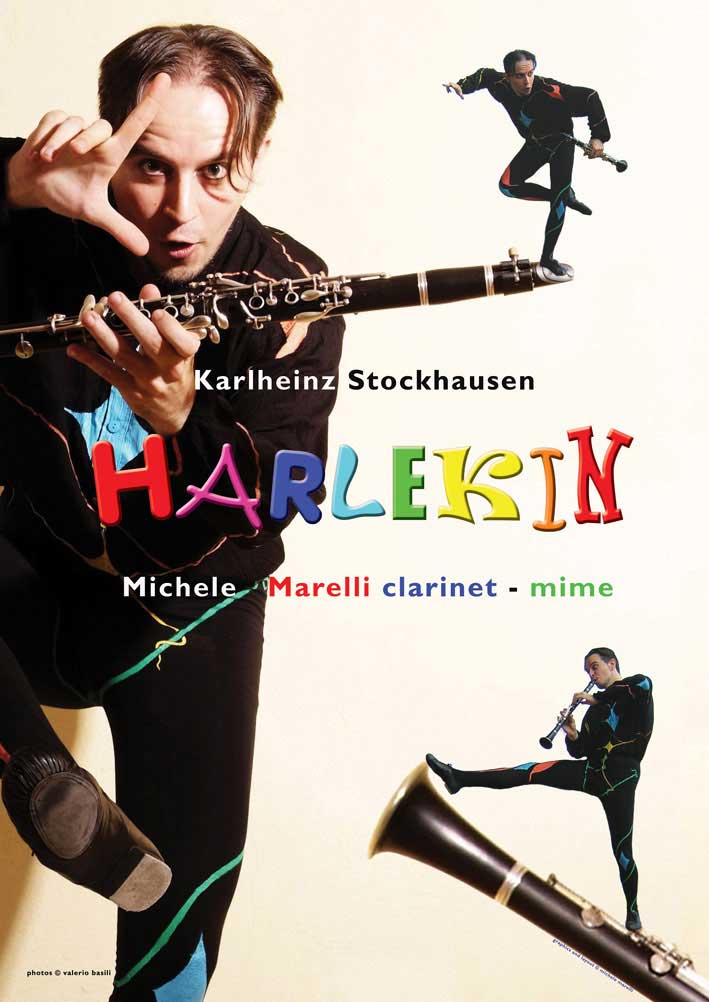

Harlekin
(1975) is one of
the best known and most appreciated of Karlheinz Stockhausen‘s works for the
originality of its mise-en-scène and mode of composition: the
clarinettist, in fact, plays, mimes and dances contemporaneously.
Stockhausen
developed the concept of the composition for Formulas already tried, in, among
others, Mantra (1970 and Inori (1972): the Formula, the extreme
evolution of the post-Weberian series, is a collection of notes, dynamics,
rhythms and detailed phrasing connected, as in a living organism, by close
internal bonds balanced by precise mathematical calculations.
Stockhausen’s
Harlequin no longer possesses almost anything of the mask of the commedia
dell’arte: the character that we see on stage does not express himself
through the word but through music and body language. Harlequin‘s unknown
aspect is revealed, his hidden essence, the seven faces of his spirit. The
pantomime, in its entirety, becomes an abstract representation of man’s life.
The
Formula of Harlekin consists of 13 sounds which evolve and are modified,
in the space of 43 minutes, through seven sections, to which Stockhausen gives
an exact title.
1st
Section “The
dream messenger”
Harlequin
comes on stage, sleepily playing a light trill on the first notes of his
Formula. Following an ideal spiral and turning around, he adds to a growing
number of sounds until he performs the entire melody in a contracted form: from
this disconnected and rhythmless phrase which represents his musical DNA,
Harlequin extracts, one by one, the notes of the Formula, holding them in the
air, and waking a little on each one of them, and attributes parameters of pitch,
rhythm and dynamics to them.
2nd
Section “The
playful constructor”
His
musical identity revealed, Harlequin explores the Formula and the space at his
disposal through
some
scores of subtle variations underlined by sharp movements of the dance.
The
Formula is extended in time, moving from a metronomic velocity of 200 to one of
36, and descends gradually from the high register to the low one of the clarinet.
3rd
Section “The enamoured lyric”
Still
in the centre of the stage, Harlequin plays the Formula in its original version
as if to enchant the listeners; he sits cross-legged with a serious expression.
4th
Section “The
pedantic teacher”
Harlequin
is seated at the centre of the stage and writing the Formula in the air with the
clarinet, trying to teach it to the listeners. Like an old master, he wants to
be as precise as possible, but he continues to make mistakes and his mood
darkens. This section has a clear pedagogical intention: the audience must
concentrate on each note, identifying pitch, duration and dynamics.
Once
the exercise has concluded, Harlequin is happy and rises to his feet; having
noted that a precise pitch of the notes corresponds to the position of the
clarinet in the air, he gives play to exaggerated evolutions and tours de
force which cause his instrument not to play correctly.
5th
Section “The roguish joker”
Harlequin,
who has regained control of his clarinet, tries to play the highest note of his
melody but does not succeed: it is the fault of the excessive length of the
instrument. With mad stratagems he achieves his purpose and exults, jumps, plays
and jokes like a buffoon.
6th
Section “The
passionate dancer”
Harlequin
dances, plays with an imaginary wind and is paralysed in photographic poses.
After having taught his Formula to his right foot, he dances with the percussive
accompaniment of his feet and is distracted from playing.
7th
Section “The spinning spirit”
Trying
not to be heard by the shadow projected on the background, Harlequin tries to
recompose the notes of his melody by arpeggios and variations. In the
light of this experience, however, he also realises that the Formula, like his
soul, has evolved and been modified. Harlequin takes his leave of the 13 notes
that have accompanied him by playing them fortissimo like a desperate cry
and making them rise to the sky in dizzying circles; having reached the last
note, however, he realises that the end is near, that it is time to go. He looks
at the space in which he was born and grew, in which he cried and rejoiced,
learnt and taught, and accepts his destiny: he plays the thirteenth note, the
top A, and ridding himself of all he possesses, finally surveys the public and
bows.
Michele
Marelli
Translated
by Jonathan West
NEW CD RELEASE! HARLEKIN by KARLHEINZ STOCKHAUSEN PUBLISHED BY STRADIVARIUS LABEL
to order it visit the website www.stradivarius.it
